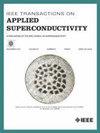Electromagnetic Force and Fault-Current Limitation of Self-Shielded HTS DC Cable Under Short-Circuit Current
IF 1.7
3区 物理与天体物理
Q3 ENGINEERING, ELECTRICAL & ELECTRONIC
引用次数: 0
Abstract
Compared to conventional cables, high-temperature superconducting (HTS) dc cable offers numerous benefits, such as low loss, high transmission current, and small volume. The self-shielding structure allows HTS dc cables to carry a larger critical current and smaller leakage magnetic field. In the event of a short-circuit fault, the current through the cable will increase several times instantaneously, and the electromagnetic force on the cable will also be greater. Therefore, it is necessary to study the electromagnetic force and current change of HTS dc cable under short-circuit current. Based on the finite element method (FEM), this article establishes a 3-D model to simulate the short-circuit electromagnetic force and current evolution of three kinds of HTS dc cables with different structures, and analyzes the changes of electromagnetic force and fault current under different structures, which is crucial for the design and operation of HTS dc cables.短路电流下自屏蔽高温超导直流电缆的电磁力与故障限流
与传统电缆相比,高温超导直流电缆具有损耗低、传输电流大、体积小等优点。自屏蔽结构使高温超导直流电缆具有较大的临界电流和较小的漏磁场。当发生短路故障时,通过电缆的电流会在瞬间增加数倍,同时作用在电缆上的电磁力也会更大。因此,有必要对短路电流下高温超导直流电缆的电磁力和电流变化进行研究。本文基于有限元法(FEM),建立三维模型,模拟了三种不同结构的高温超导直流电缆的短路电磁力和电流演变,分析了不同结构下电磁力和故障电流的变化,这对高温超导直流电缆的设计和运行至关重要。
本文章由计算机程序翻译,如有差异,请以英文原文为准。
求助全文
约1分钟内获得全文
求助全文
来源期刊

IEEE Transactions on Applied Superconductivity
工程技术-工程:电子与电气
CiteScore
3.50
自引率
33.30%
发文量
650
审稿时长
2.3 months
期刊介绍:
IEEE Transactions on Applied Superconductivity (TAS) contains articles on the applications of superconductivity and other relevant technology. Electronic applications include analog and digital circuits employing thin films and active devices such as Josephson junctions. Large scale applications include magnets for power applications such as motors and generators, for magnetic resonance, for accelerators, and cable applications such as power transmission.
 求助内容:
求助内容: 应助结果提醒方式:
应助结果提醒方式:


